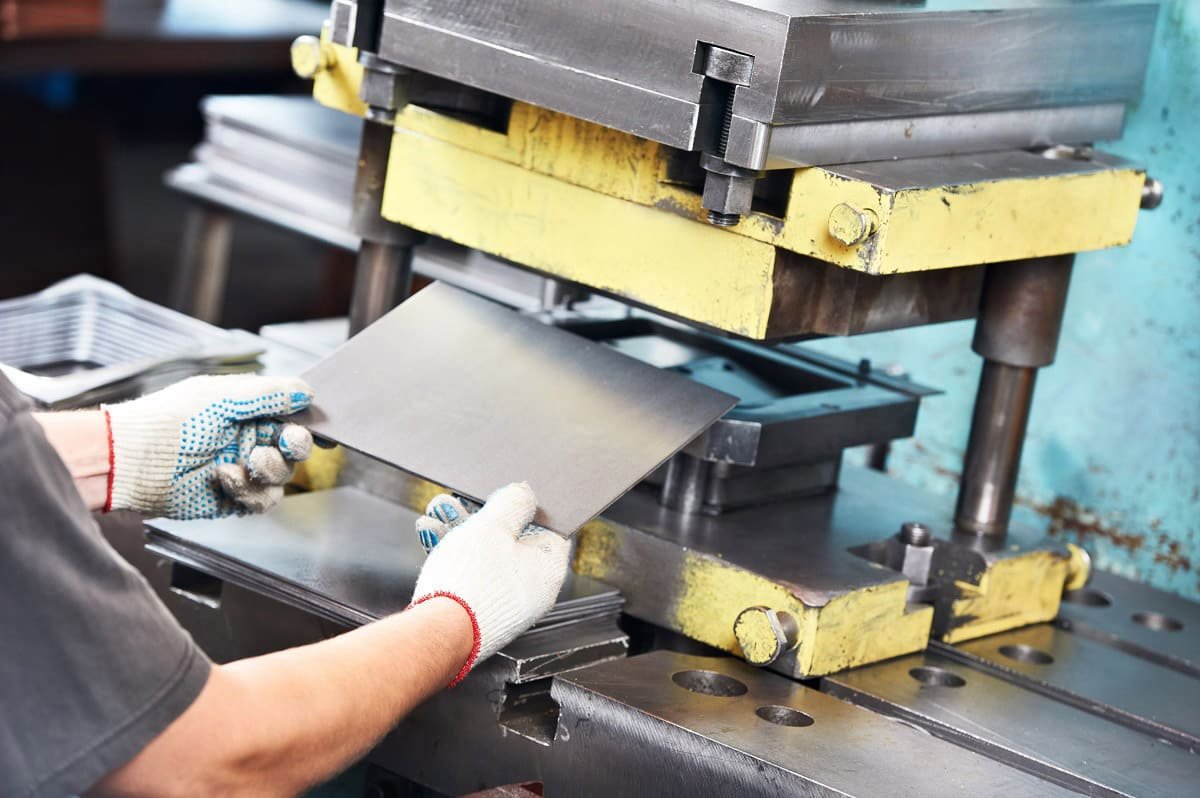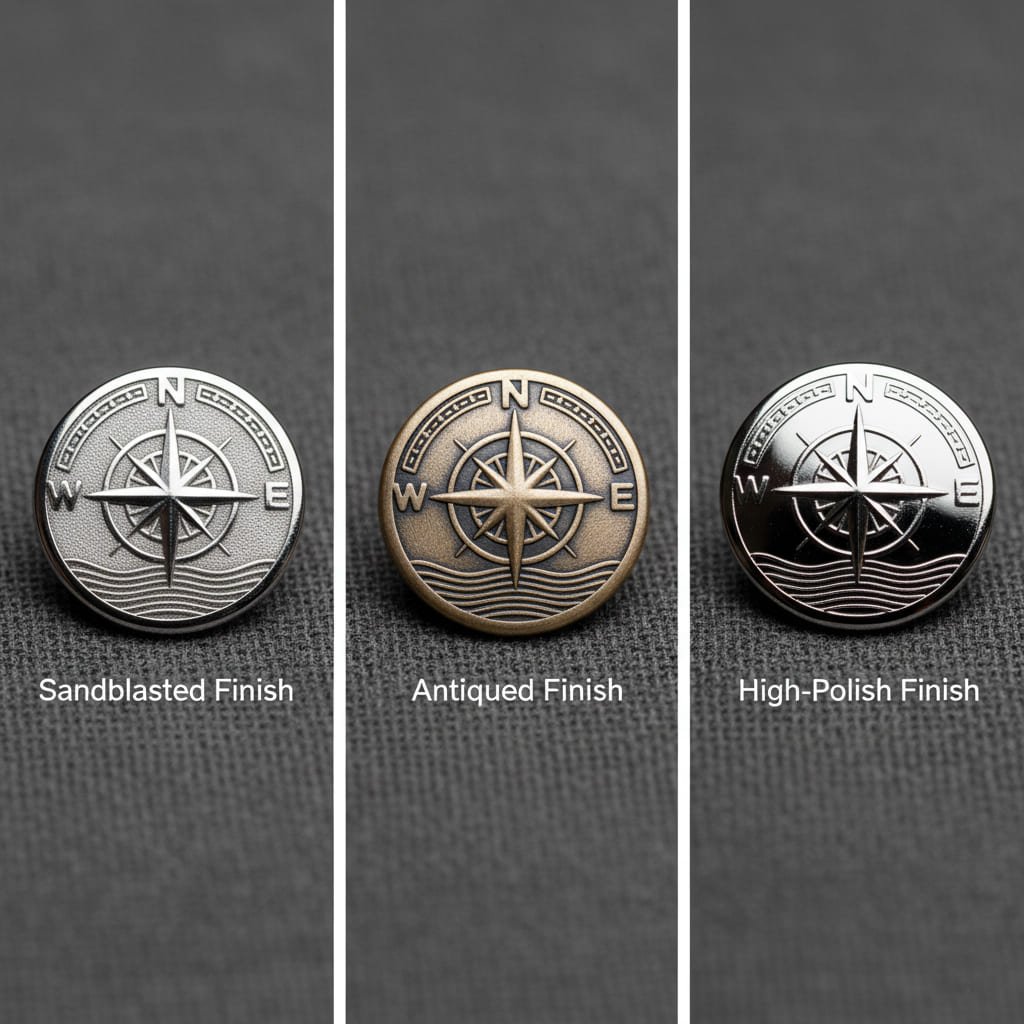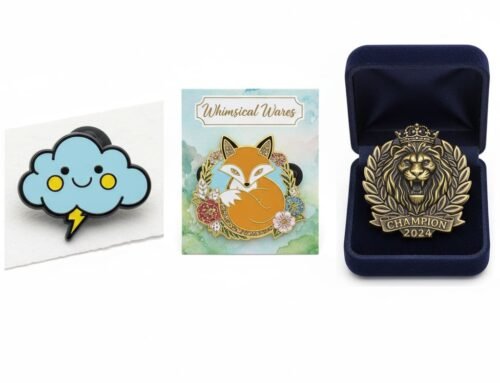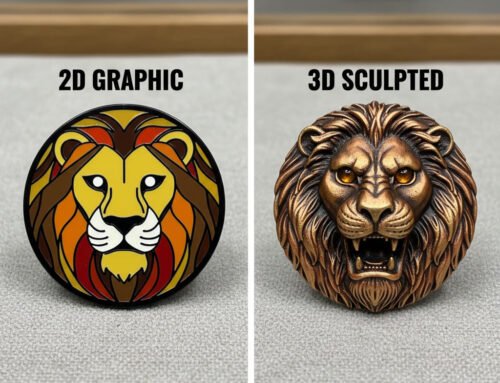In a world saturated with vibrant colors, sometimes the most powerful statement is made with pure, timeless metal. Die-struck pins represent the pinnacle of classic design, where texture, light, and shadow take center stage. They are not simply pins without color; they are miniature metal sculptures that convey a message of permanence, quality, and understated elegance.
This is your definitive guide to mastering the art of the die-struck pin. We will explore every facet of this unique style—from its rich history and detailed manufacturing process to the expert design techniques that make it sing. Whether you’re a seasoned procurement manager creating service awards or a brand seeking a touch of class, this guide will provide you with the knowledge to create a sophisticated, high-impact pin that truly stands the test of time. This is a crucial first step in the overall journey, which you can learn more about in our Panduan Utama untuk Pin Kerah Khusus.
Daftar isi
- What Exactly is a Die-Struck Pin? The 30-Second Answer
- From a Block of Steel to a Work of Art: The Die-Struck Journey
- A Masterclass in No-Color Design: Thinking in Texture and Light
- When Should You Choose a Die-Struck Pin?
- How Does Die-Struck Compare to Other Pin Styles?
- Ordering and Cost: What to Expect
- Conclusion: When Metal Tells the Whole Story
- Frequently Asked Questions about Die-Struck Pins
- Ready to Create Your Classic Metal Pin?
- Související příspěvky
What Exactly is a Die-Struck Pin? The 30-Second Answer
A die-struck pin is a custom pin created by stamping a design into a sheet of metal, creating raised and recessed areas. It features no enamel color fill. Its entire aesthetic is derived from the texture and finish of the metal itself, resulting in a classic, formal, and elegant “tone-on-tone” appearance.
Core Concept Table: Die-Struck vs. Enamel Pins
Key Differences at a Glance
| Feature | Die-Struck Pin | Standard Enamel Pin |
|---|---|---|
| Color | None. The design is 100% metal. | Yes. Recessed areas are filled with vibrant colored enamel. |
| Texture | Highly Textured. Relies on raised, recessed, and specially textured areas. | Varies (textured for soft enamel, smooth for hard enamel). |
| Aesthetic | Classic, formal, elegant, vintage, prestigious. | Varies from playful and artistic to professional and modern. |
| Best For | Corporate logos, service awards, anniversaries, minimalist designs. | Brands, art, promotions, and any design where color is a key element. |
From a Block of Steel to a Work of Art: The Die-Struck Journey
The name “die-struck” comes directly from its manufacturing process. Understanding this journey reveals why these pins are so durable and capable of capturing such fine detail. It’s a testament to the power of traditional metalworking, refined with modern precision.
Step 1: The Blueprint – The Critical Role of Vector Artwork
Every great pin begins with a perfect digital blueprint. For a die-struck pin, where the detail is entirely dependent on the quality of the metal lines, a flawless piece of artwork is essential. The factory’s machinery needs a set of precise instructions to follow, and that’s exactly what a vector file provides. For a complete understanding of why this file type is so important, please read our Panduan Sederhana untuk Karya Seni Vektor untuk Non-Desainer.
Step 2: Creating the Die (The Mold)
Once the vector artwork is finalized, it is fed into a CNC (Computer Numerical Control) machine. This machine precisely engraves the design into a block of hardened steel, creating a reverse-image “die” or mold. The incredible precision of this step is what allows for the capture of fine details in the final product.
Step 3: The Stamping Process (The “Strike”)
This is where the magic happens. A powerful hydraulic press, applying immense pressure, strikes the die into a sheet of raw base metal (typically brass, copper, or iron). This action impresses the design deep into the metal, creating the distinct raised and recessed levels that form the basis of the pin’s design. This single, powerful strike is what gives the pin its name.

Step 4: Trimming and Finishing
After stamping, the individual pin shape is cut from the metal sheet using a trimming tool. This is also when any planned cutouts are pierced through the metal. At this point, instead of going to the enamel-filling department like a color pin would, the die-struck pin moves on to specialized finishing stations. This is where texturing techniques like sandblasting are applied, a crucial step we’ll explore in the design section below.
Step 5: Plating, Polishing, and Final Assembly
Finally, the pin is electroplated with its final metal finish. The raised areas are then highly polished to a brilliant, mirror-like shine, creating a beautiful contrast with any textured recessed areas. The last step is to weld the backing attachments on and conduct a rigorous quality control inspection to ensure every detail is perfect.
A Masterclass in No-Color Design: Thinking in Texture and Light
Designing a die-struck pin requires a shift in thinking. Without color, your primary design tools are no longer hue and saturation; instead, they are depth, texture, and the interplay of light and shadow. A great die-struck design is a conversation between shiny and matte, raised and recessed. Mastering this is key to creating a truly sophisticated piece.
The Power of Contrast: Combining Finishes for Maximum Impact
This is the heart of die-struck design. By combining different metal textures, you can make your design pop and ensure every detail is legible and impactful.
- Sandblasting: This is the most popular texturing method. The recessed areas of the pin are blasted with a fine grit, creating a grainy, matte finish. This contrasts beautifully with the highly polished, mirror-like raised surfaces, giving the design a clean, modern, and highly readable look.
- Antique Finishes: An antique plating (e.g., antique silver, antique bronze) is a game-changer for adding depth. This process applies a dark chemical patina that settles into the recessed areas, creating an immediate sense of age, dimension, and character. It is often the best choice for making fine text highly legible.
- High Polish Only: For the purest expression of metal, some designs use a high polish on both the raised and recessed surfaces. This creates a brilliant, mirror-like effect that is best suited for simple, bold shapes where the form itself is the main focus.
- Brushed Finishes: A more modern and subtle option, a brushed finish gives the metal a sophisticated, satin-like texture with fine parallel lines. This reduces glare and creates a refined elegance.

Texture and Finish Options Table
Choosing the Right Finish for Your Aesthetic
| Finish Combination | Visual Effect | Best For |
|---|---|---|
| High Polish + Sandblast | High contrast, shiny vs. matte. | Modern corporate logos, clean designs. |
| Antique Plating | Vintage, weathered, high detail visibility. | Text-heavy designs, historical seals, university crests. |
| High Polish Only | Brilliant, mirror-like, pure metal. | Simple, bold shapes and symbols. |
| Brushed Finish | Sophisticated, non-reflective, satin look. | Professional awards, minimalist aesthetics. |
Designing with Depth: The Difference Between 2D and 3D Relief
Itu “relief” of a pin refers to the way the surface is sculpted. This choice has a significant impact on the final look and cost.
- 2D Relief: This is the most common and cost-effective style. It features two main levels: a single raised level and a single recessed level. The lines are clean and the surfaces are flat, which is perfect for most logos and graphic designs.
- 3D Relief: This is a more complex, sculptural style. Instead of just two flat levels, a 3D design features multiple levels of depth and smoothly curved, rounded surfaces, much like the face on a coin. This adds a stunning, realistic quality but requires a more complex and costly mold. For more details on this process, see our guide on 3D vs. 2D Molds.
When Should You Choose a Die-Struck Pin?
With so many options available, when is the classic, no-color die-struck pin the right strategic choice for your project? This style excels in situations where the message is one of elegance, permanence, and prestige.

- Corporate and Brand Identity: A die-struck pin is the metal equivalent of a well-tailored suit. It presents a brand as professional, established, and trustworthy. It is a statement of quiet confidence, perfect for industries where tradition and reliability are key.
- Years of Service and Employee Recognition: This is a primary market for die-struck pins. They are the top choice for service awards because their value is inherent in the metal itself. They feel permanent and substantial, making them a fitting tribute to an employee’s long-term commitment. Our case study on employee morale pins highlights this powerful application.
- Anniversaries, Clubs, and Fraternal Organizations: When a sense of history, tradition, and heritage is important, die-struck is the way to go. An antique finish on a die-struck pin can make it feel like a cherished artifact, perfect for commemorating a milestone.
How Does Die-Struck Compare to Other Pin Styles?
To help you make the best decision, it’s useful to see how die-struck pins stack up against their colorful counterparts. Each style has its own unique strengths.
The Master Comparison Table
Die-Struck vs. Enamel vs. Printed Pins
| Feature | Die-Struck Pin | Soft Enamel Pin | Hard Enamel Pin | Pin yang Dicetak |
|---|---|---|---|---|
| Use of Color | None (100% Metal) | Yes, vibrant solid colors | Yes, premium solid colors | Yes, full photographic color |
| Primary Aesthetic | Classic, Elegant, Formal | Textured, Vibrant, Playful | Smooth, Polished, Jewelry-like | Photographic, Detailed |
| Key Feature | Metal Texture & Relief | Raised Metal Lines | Smooth, Flat Surface | Full-Color Gradients |
| Durability | Extremely High | Good | Extremely High | Good (with epoxy) |
| Relative Cost | $-$$ (Cost-effective) | $ (Most affordable) | $$$ (Premium) | $$ (Mid-range) |
| Best for Detail | Good for textural detail. | Excellent for fine line detail. | Good, but polishing can soften lines. | Best for photographic detail. |
For a deeper dive into the most common comparison, check out our guide on Hard Enamel vs. Soft Enamel.
Ordering and Cost: What to Expect
One of the most attractive features of the die-struck style is its cost-effectiveness. The pricing follows the same core principles as other pins—it’s primarily determined by size and quantity—but it has a distinct advantage.
Because the time-consuming and labor-intensive process of hand-filling multiple enamel colors is eliminated, die-struck pins can be one of the most affordable options available, especially when compared to a multi-color hard enamel pin. This makes them an excellent choice for achieving a high-perceived-value look on a controlled budget. For a full pricing overview, please see our Complete Breakdown of Custom Pin Pricing.
Conclusion: When Metal Tells the Whole Story
Die-struck pins are the ultimate choice for designs that value timeless elegance, professionalism, and the inherent beauty of metal. They are not pins that simply lack color; they are pins where the metal is the color, the texture, and the message. By choosing this classic style, you are making a statement of quality and permanence that will represent your brand with distinction for years to come.
The final step in ensuring this classic piece is perfectly functional is selecting the right backing. A premium pin deserves a secure fastener, a topic we cover in detail in Panduan Ultimate untuk Pin Backings & Lampiran.
Frequently Asked Questions about Die-Struck Pins
- Is a die-struck pin the same as a stamped pin?
- Yes, for all practical purposes, the terms are used interchangeably in the industry. “Die-struck” specifically refers to the manufacturing process of striking a die into metal, which is how these pins (and the metal bases for enamel pins) are made.
- Can I add just one or two colors to a die-struck pin?
- Absolutely! But at that point, it technically becomes a Soft or Hard Enamel pin. The term “die-struck” is specifically used by manufacturers to refer to pins with no color fill. Simply specify the enamel type when ordering.
- What is the best metal plating for a die-struck pin with a lot of text?
- An antique finish (antique gold, silver, or bronze) is almost always the best choice. The dark patina that settles in the recessed areas makes the raised metal letters incredibly easy to read, even at a small size.
- Are die-struck pins cheaper than enamel pins?
- They are generally less expensive than a hard enamel pin with multiple colors due to the reduced labor. Their cost is often very similar to a basic soft enamel pin of the same size and quantity, making them an excellent value.
Ready to Create Your Classic Metal Pin?
Our team of experts specializes in bringing out the best in metal. Send us your logo or design, and we will provide a free digital proof showing how your concept will look as a sophisticated die-struck pin, complete with recommendations for the perfect finish to make it stand out.




